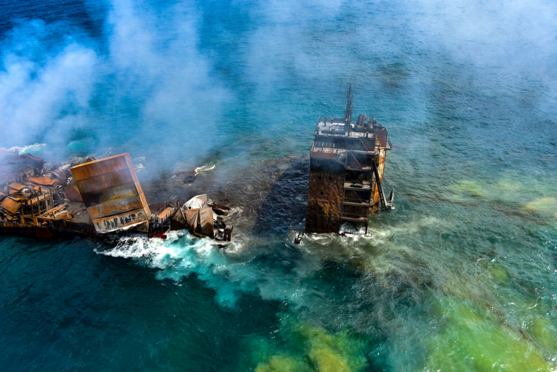A year since X-Press Pearl sinking, Sri Lanka is still waiting for compensation
By Malaka Rodrigo
COLOMBO — A year since the sinking of the cargo ship the X-Press Pearl, Sri Lanka continues to clean its beaches of the plastic pellets that the vessel was carrying, and still trying to claim compensation for the environmental damage wrought.
An expert committee investigating the extent of damage to the country’s marine and coastal environment has now concluded the disaster to be the worst in terms of chemical and plastic pollution of the sea. That’s according to Ajith de Alwis, co-chair of the X-Press Pearl damage assessment committee and a professor of chemical and process engineering at the University of Moratuwa.
The committee has submitted its assessment report to the Attorney General’s Office for use in claiming compensation from the Singapore-based operators of the ship.
“However, the report is only the first edition of the damage assessment, and further assessments would continue based on the monitoring,” De Alwis said.
Maritime law expert Dan Malika Gunasekera said Sri Lankan authorities have taken a long time to file for compensation and are reluctant to go through years of strenuous legal battles in international courts. Sri Lanka has obtained an interim payment of $3.7 million in damages, but the country could claim as much as $5 billion to $7 billion, according to Gunasekera.
With Sri Lanka currently mired in the worst economic crisis in the country’s history, those higher numbers would prove a much-needed injection of foreign currency. But further delays would diminish the cash-strapped island’s chance of getting sufficient compensation for the environmental damage, said Gunasekera.
Worst plastic marine pollution event
X-Press Pearl was carrying 1,486 containers when it caught fire off Colombo on May 20, 2021, and began sinking. Eighty-one of the containers were labelled hazardous, and the cargo included 25 metric tonnes of nitric acid — a key ingredient in the production of explosives, and touted as a possible factor for the fire. There were several explosions, and it took more than a week to bring the fire under control. Attempts to tow the vessel to deeper waters failed, and the freighter finally sank on June 2, 2021, a few kilometres off Sri Lanka’s western coast.
The ship was also carrying 400 containers of nurdles, the plastic pellets from which all manufactured plastic goods are made. The spill of the more than 50 billion pellets made this the worst plastic marine pollution event in the world, with the pellets quickly spreading along the beaches of Sri Lanka’s western coast.
The government carried out an initial clean-up of the beaches, but subsequent cleaning was done by volunteers like the Pearl Protectors, a youth organization.
“We had 28 major cleaning operations on main beaches and could collect as much as 1,500 kilograms [3,300 pounds] of nurdles,” said Muditha Katuwawala, coordinator of the Pearl Protectors.
But more nurdles keep washing up on the beaches, and with the island currently experiencing the southwest monsoon, nurdles that had initially sunk to the seabed or were trapped in underwater structures such as corals have been washed free and are making landfall.
“So it needs to be continuous work” cleaning up the beaches, Katuwawala said.
The Pearl Protectors, like other volunteer organizations around the program, are suffering from the economic crisis. The cost of organizing has doubled in the span of the last few months, with inflation hitting a record 39% in May. The country has defaulted on loan payments for the first time, while the local currency, the rupee, has nosedived against the US dollar.
Salvage operation
As for the wreck of the X-Press Pearl, it’s now being salvaged by the Shanghai Salvage Company (SSC), which was handed the task by the ship’s owners, Singapore-based X-Press Feeders. In a statement, X-Press Feeders said the salvage operation includes round-the-clock monitoring to deal with debris or other pollutants that may get dislodged during the operation. It also said regular water sampling will be carried out at the site, and that any oil spills will be responded to immediately.
According to SSC, the X-Press Pearl’s hull has essentially broken in half, so the wreck will be recovered as two separate sections. Operations were suspended at the end of April due to rough seas caused by the southwest monsoon.
Cleanly separating the two halves of the hull is due to start in November, after the monsoon, while the actual lifting is expected to begin in February 2023. The final phase, to be completed by September 2023, will see the wreck completely dismantled, recycled, and disposed of.
Lack of baseline studies
Terney Pradeep Kumara, a marine biologist who previously headed Sri Lanka’s Marine Environment Protection Agency (MEPA), said it’s important to collect data during the salvation operation that can serve as evidence linking the environmental pollution to the X-Press Pearl. In the aftermath of the ship accident, marine biologists noted an unusually high number of sea turtle mortalities, which they suspect was the result of the pollution, but for which they currently lack definitive evidence.
‘Not having a baseline of the environmental conditions has been one of the biggest challenges in doing this environmental assessment,” said Prasanthi Gunawardene, the other co-chair of the X-Press Pearl damage assessment committee. There were about 30 different subcommittees with members from different fields, and getting input from different government agencies in the monitoring process was a challenge, said Gunawardene.
-This article was originally featured on news.mongabay.com


